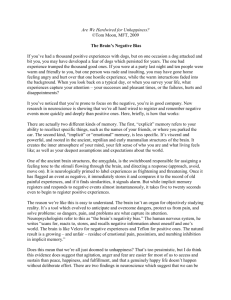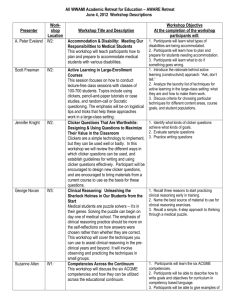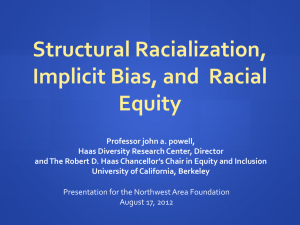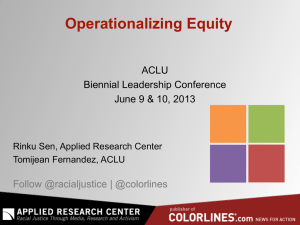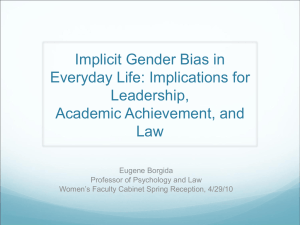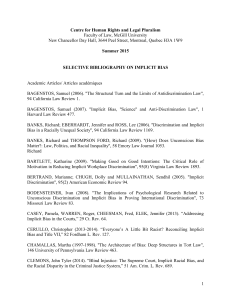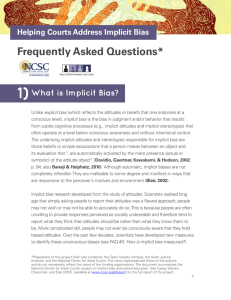Implicit Bias_powell_March_19 jp2
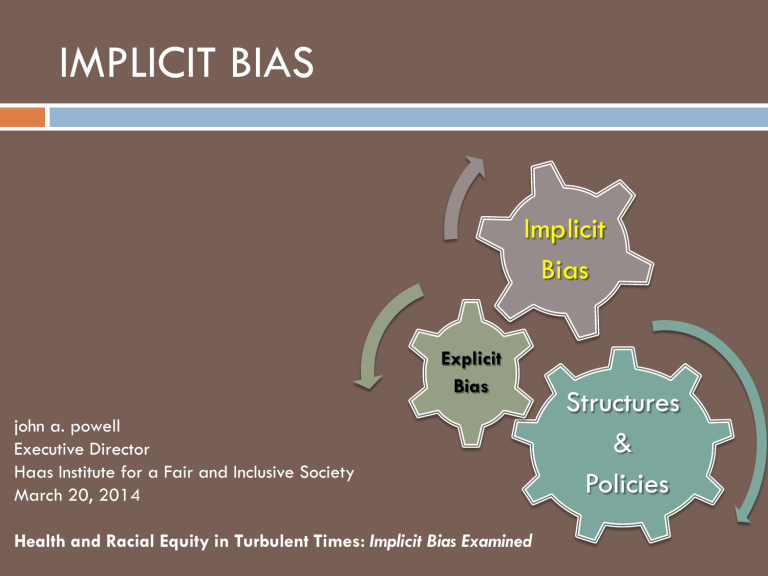
IMPLICIT BIAS
Implicit
Bias
Explicit
Bias john a. powell
Executive Director
Haas Institute for a Fair and Inclusive Society
March 20, 2014
Health and Racial Equity in Turbulent Times: Implicit Bias Examined
Structures
&
Policies
Definitions
Bias – the evaluation of one group and its members relative to another
Expressed directly/explicitly: “I like whites more than Latinos.”
Expressed indirectly: E.g., Sitting further away from a Latino than a white individual.
Explicit = Person is aware of his/her evaluation
Implicit = Person doesn’t perceive or endorse evaluation
Source: Unconscious (Implicit) Bias and Health Disparities: Where Do We Go from Here?
Implicit Bias
The human brain can take in 11 million pieces of information in any one moment
We’re only consciously aware of maybe 40 of these - at best.
Only 2% of emotional cognition is available to us consciously
Racial bias tends to reside in the unconscious network
Messages can be framed to speak to our unconscious
4
Neurological Origins
Limbic system – categorizes what we perceive
The limbic system is a very old part of the brain; it can be found in animals.
It is also very fast.
One part of the limbic system, the amygdala, is responsible for strong emotional responses (i.e., fight or flight)
The Art of Happiness in a Troubled World. By the Dalai Lama and Howard Cutler. (2009). Graphic - <www.buzzle.com/articles/the-role-of-values-in-wisdom.html>
Schemas
5
They help us organize information into broader categories and conserve mental resources
objects (e.g., “chairs”) behaviors (e.g., “ordering food”) human being (e.g., “the elderly”)
Situational cues
Schemas and the unconscious are social. They exist in and our shaped by our environment.
Experiences with other people
Perceptions of structures
Narratives
Stories, books, movies, media, and culture
Our Unconscious Networks
What colors are the following lines of text?
6
Same drill.
What colors are the following lines of text?
7
Awareness Test
http://www.youtube.com/watch?v=yrqrkihlw-s
Internalized Perceptions
9
We unconsciously think about race even when we do not explicitly discuss it.
You can’t avoid bias by avoiding race; it does not work.
Conversations about race are not easy, but they are vital.
Environments & narratives matter
Source: Lester, Julius. Let’s Talk About Race
Identifying & Measuring Implicit Bias
Ask people/Self-Reporting?
Not reliable or popular in a post-civil rights era
Subconscious thoughts are outside people’s awareness or conscious thoughts
Physiological
Increase in heart rate, sweat glands, blood pressure, brain activity
Reaction Time Measurements
IAT (*will be covered by other panelist)
Experiential
Consistent disparate outcomes even when controlling for factors
And how do we internalize these perceptions?
High
PITY: women, elderly, disabled
Your own group, who you identify with
Warmth
Low
Low
DESPISED:
African
Americans,
Immigrants,
Prisoners
Latinos / Latinas?
Competence
COMPETENT, but don’t really like
them: Asians
High
Source: Douglas Massey. Categorically Unequal: The American Stratification System. New York: Russell Sage Foundation. 2007.
Interpersonal Intervention is Needed…
Source: Unconscious (Implicit) Bias and Health Disparities: Where Do We Go from Here?
13
… but it is not enough.
Implicit Bias Interacts with External Structures and Networks
Source: Barbara Reskin. http://faculty.uwashington.edu/reskin/
E.g., Implicit Bias Increases Neighborhood
Segregation and Neighborhood Segregation
Creates Implicit Bias
Segregation impacts a number of life-opportunities
Impacts on Health
School Segregation
Educational Achievement
Exposure to crime
Transportation limitations and other inequitable public services
Neighborhood
Segregation
Job segregation
Racial stigma, other psychological impacts
Community power, civic participation and individual assets
Adapted from figure by Barbara Reskin at: http://faculty.washington.edu/reskin/ 14
14
Brain as a network
Our brains are connected to each other
Brain as a network
Our brains are also connected to the environment
Racialized Outcomes Created Through
Interacting Processes
Implicit Bias
(Communication)
Power
(Organization &
Collaboration)
Impact
Structural
Racialization
19
20
Interventions Should Account for
Interconnectivity and Situatedness
Universal
Programs
Targeted
Programs
Targeted
Universalism
Targeted Universalism
Structural Inequity produces consistently different outcomes for different communities.
Targeted Universalism responds with universal goals and targeted solutions
VS.
Structural Inequity
©2012 Connie Cagampang Heller
Targeted Universalism
Linked Fates
22
“We are all caught up in an inescapable network of mutuality, tied in a single garment of destiny. Whatever effects one directly effects all indirectly.”
-The Rev. Dr. Martin Luther King, Jr.
Illustrating the Problem of Inequality for All
23
24
Must Expand the Circle of Human Concern
Segregated and isolated groups
Citizens
Mothers
Undocumented
Immigrants
Elderly
Children
Felons
Non-public/non-private
Space: African
Americans/Latinos
25
For more information, visit: http://www.iupress.indiana.edu/catalog/806639
LOCAL AND REGIONAL GOVERNMENT
ALLIANCE ON
RACE & EQUITY
Institutional / Explicit
Policies which explicitly discriminate against a group.
Example:
Police department refusing to hire people of color.
Institutional / Implicit
Policies that negatively impact one group unintentionally.
Example:
Police department focusing on streetlevel drug arrests.
Individual / Explicit
Individual / Implicit
Prejudice in action – discrimination.
Example:
Police officer calling someone an ethnic slur while arresting them.
Unconscious attitudes and beliefs.
Example:
Police officer calling for back-up more often when stopping a person of color.
